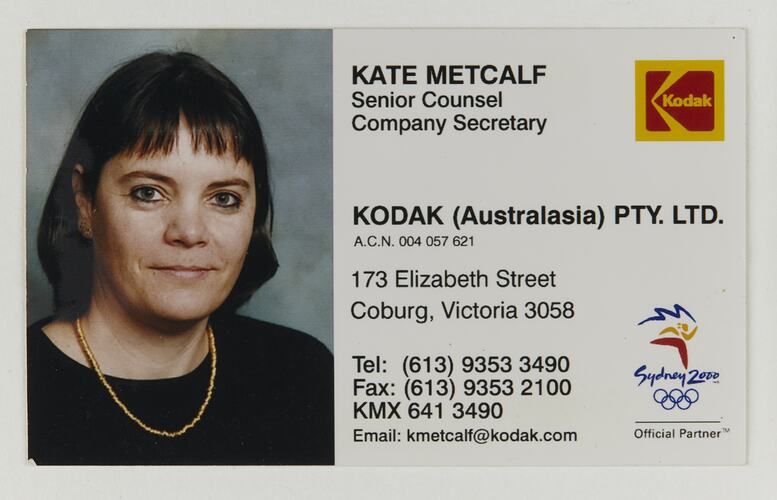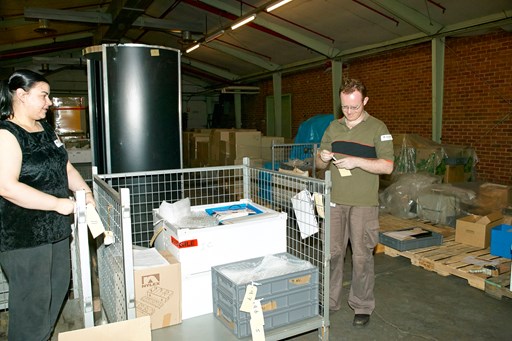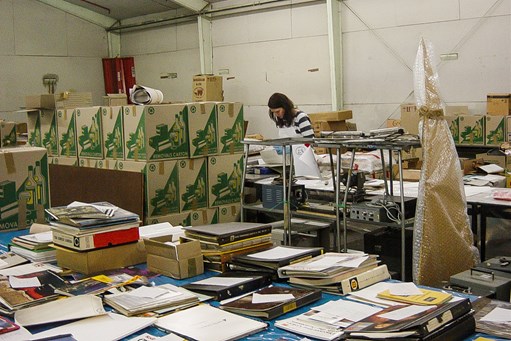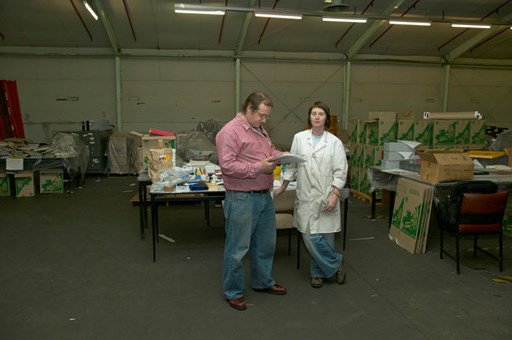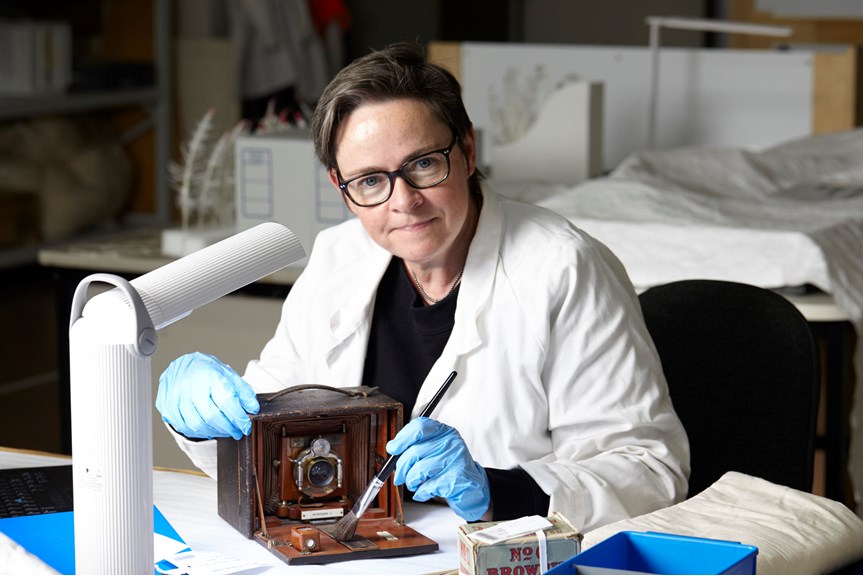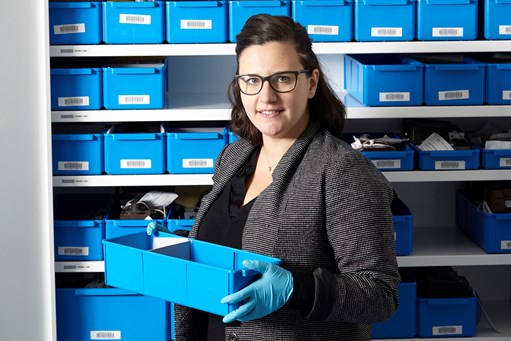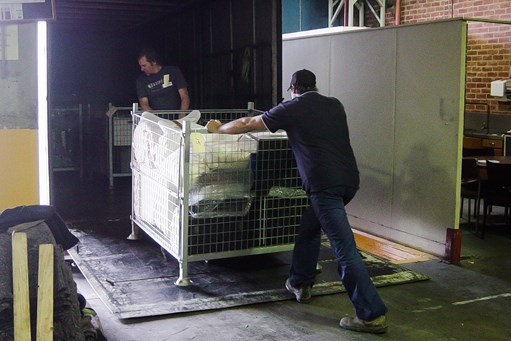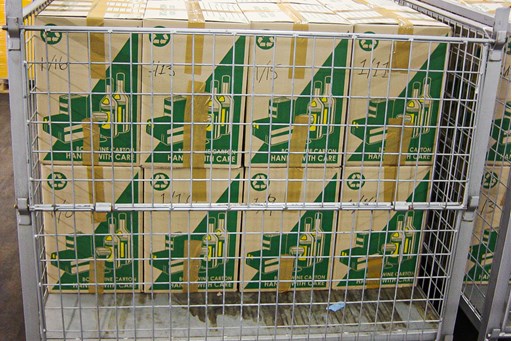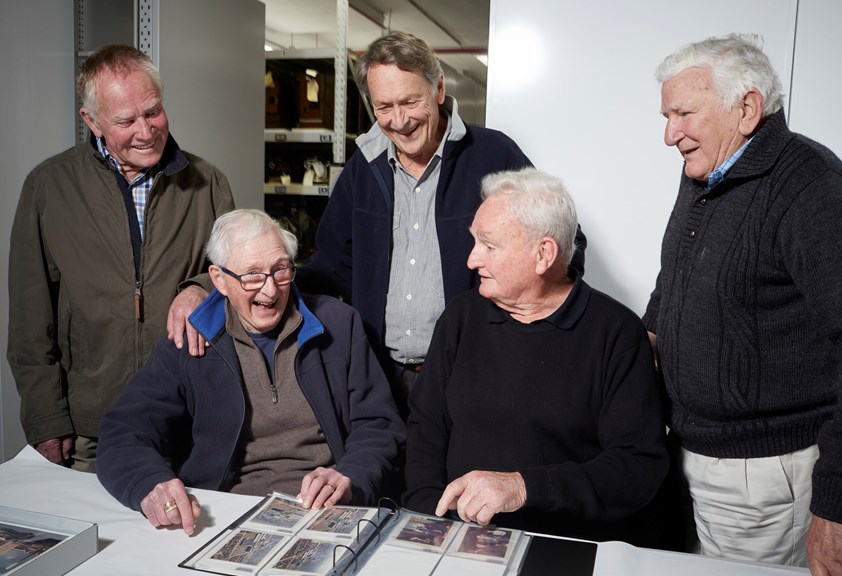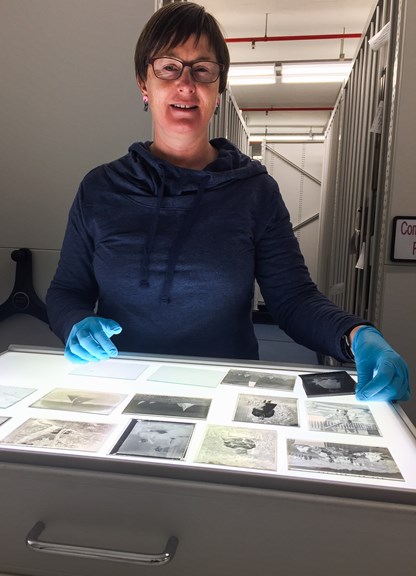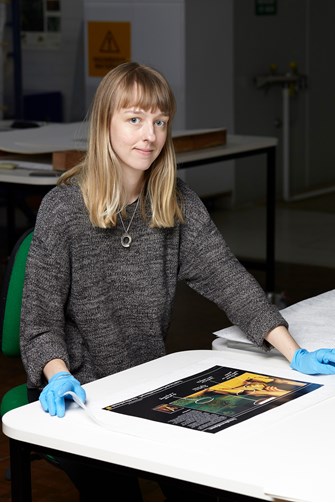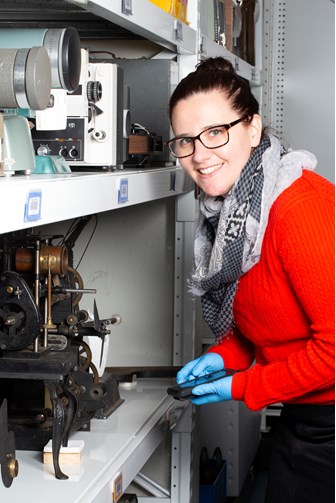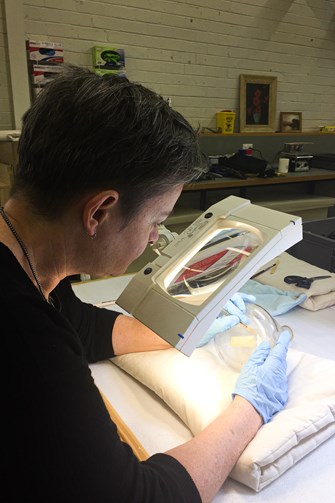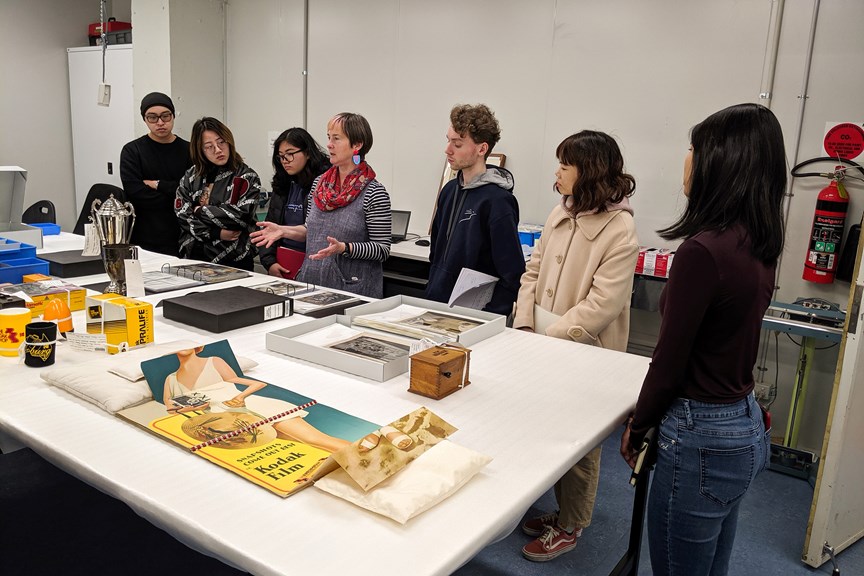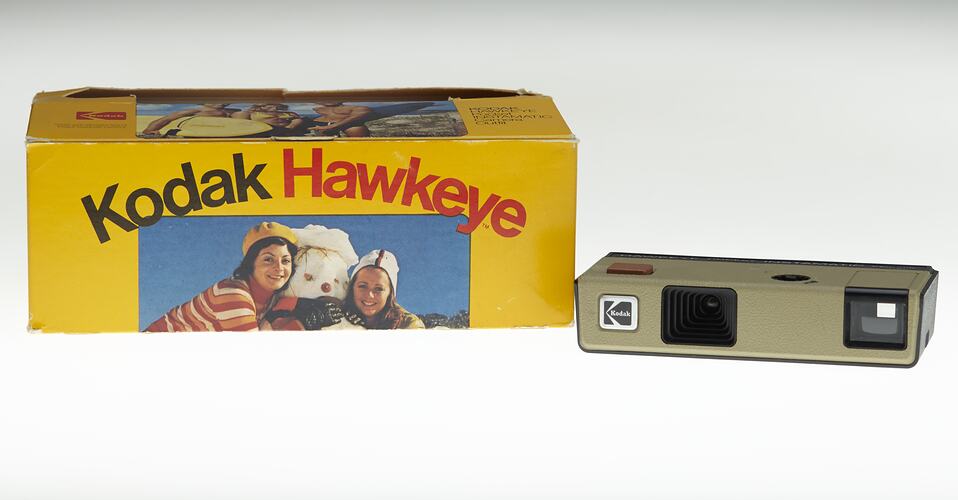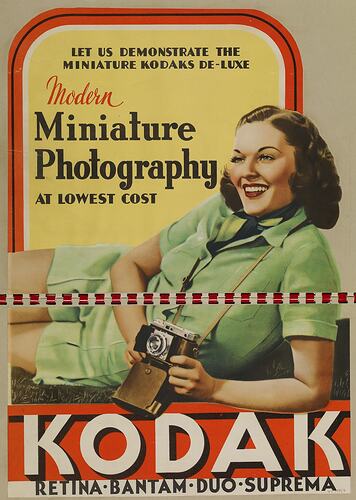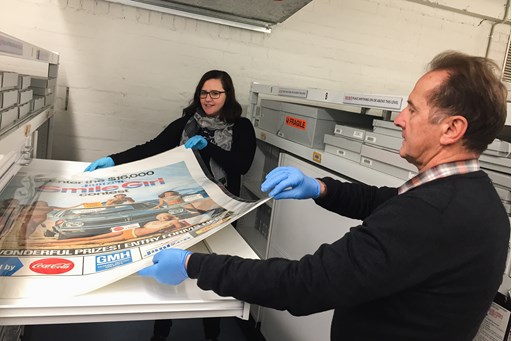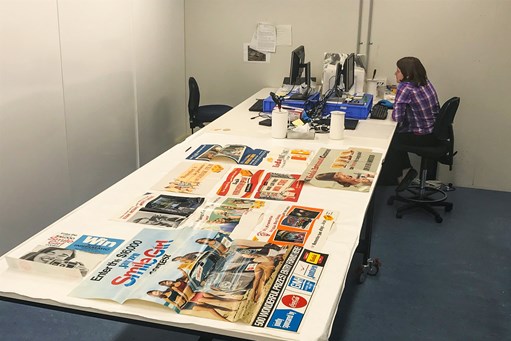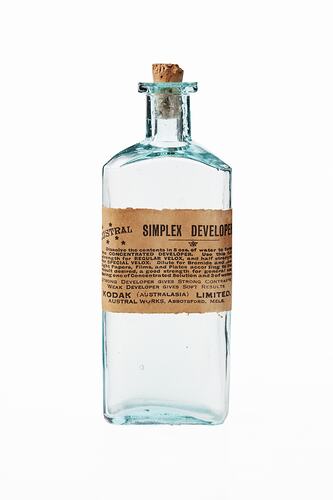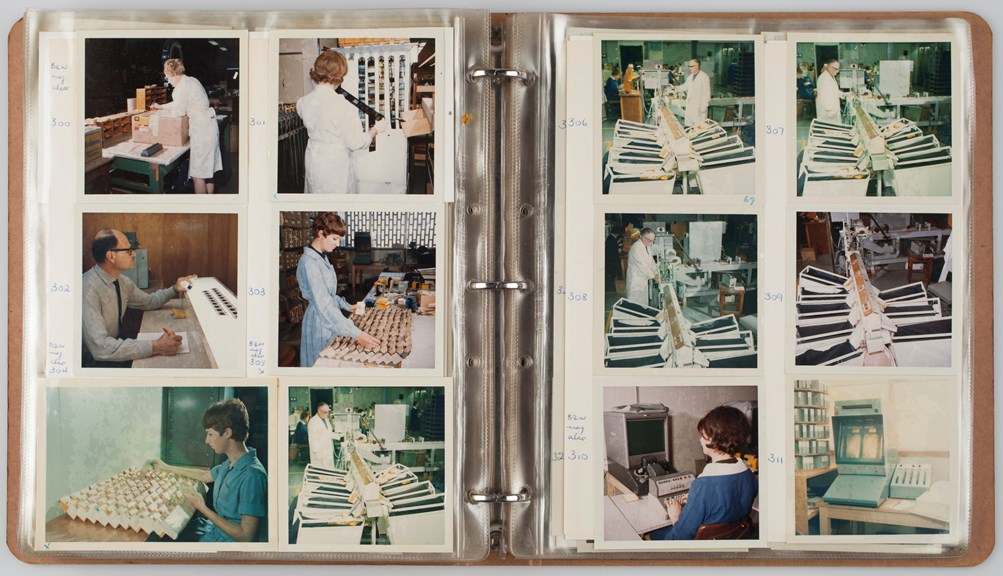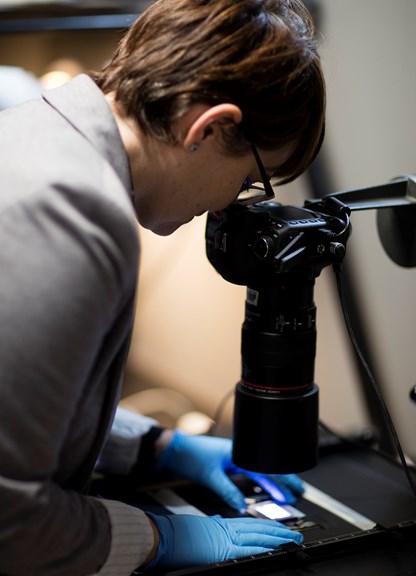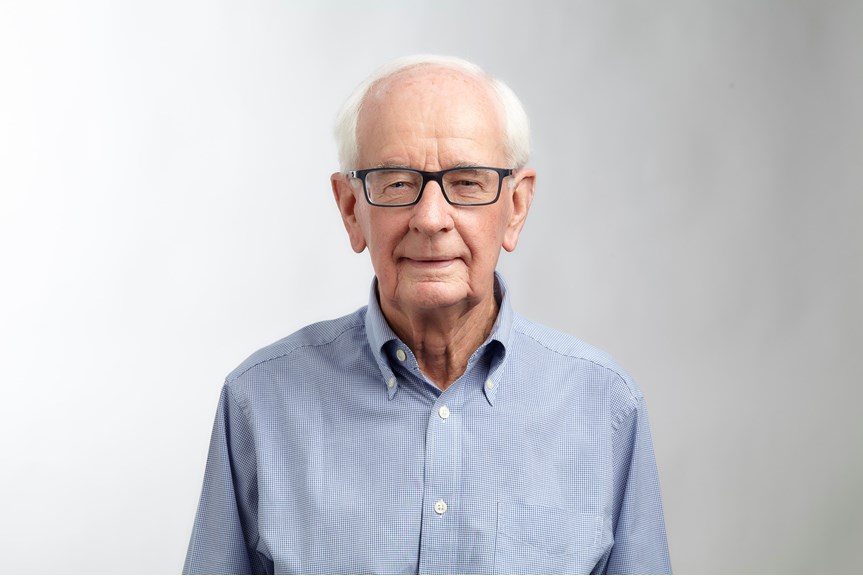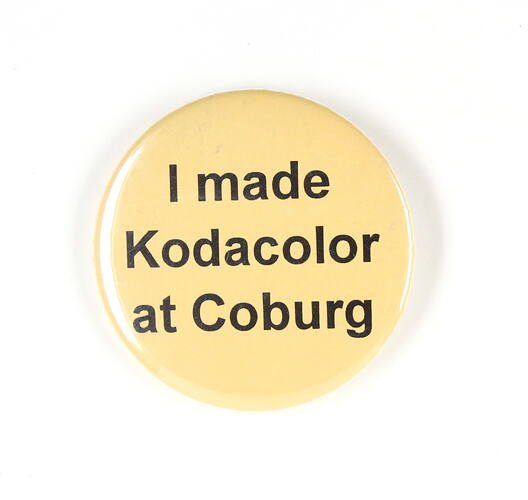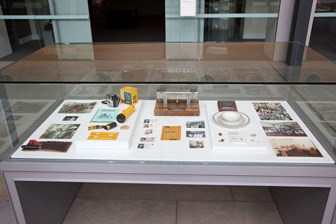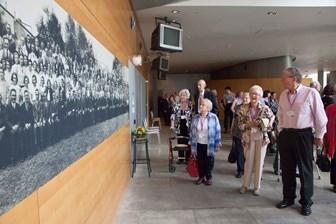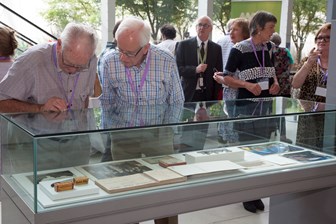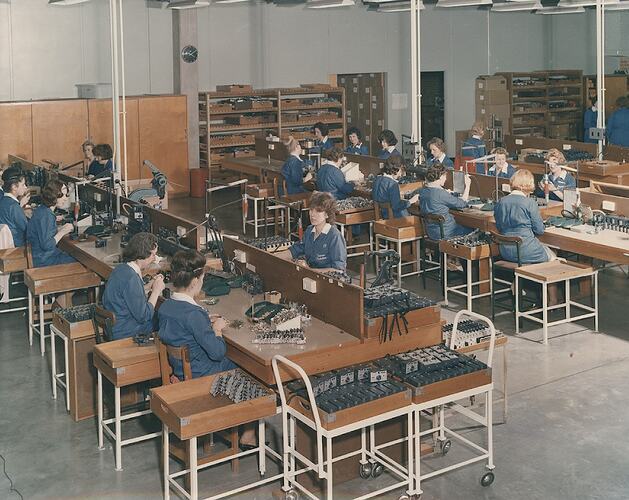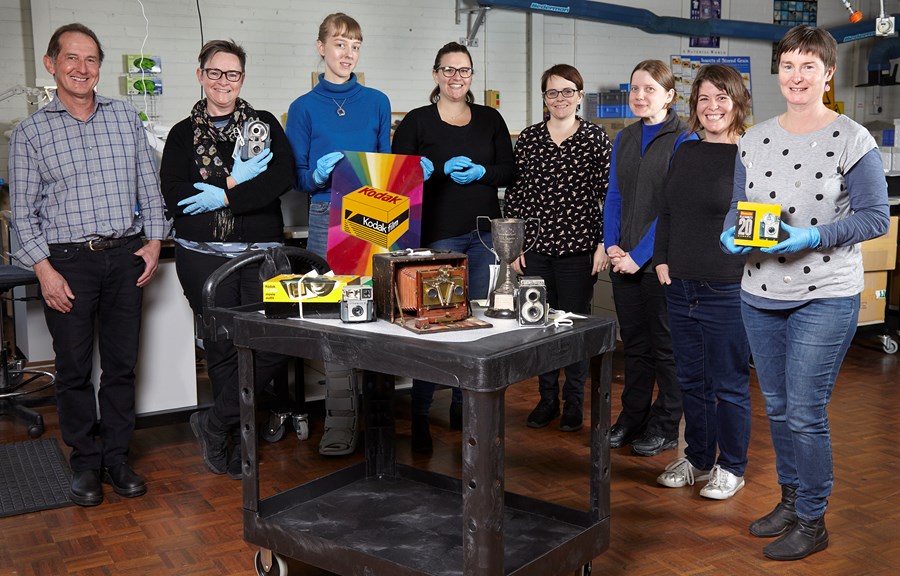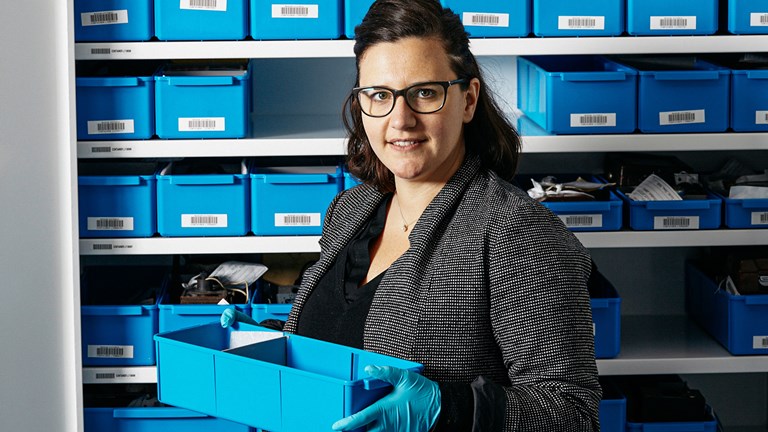
Kodak Collection Project
From Kodak Moment to Lasting Legacy
In November 2004, Kodak Australasia’s Coburg factory ceased operations, shutting off machinery and closing its doors for the last time. This closure not only resulted in approximately 1000 staff members losing their jobs, but also marked the end of Kodak Australasia’s long history of manufacturing in Melbourne, Victoria.
In 2005, following the factory closure and while the site was still being dismantled, many thousands of objects, photographs and documents from the Coburg factory began to arrive by the truckload at Museums Victoria’s storage facility, marking the beginning of the museum’s Kodak Heritage Collection. This is the story of that expansive collection and how – in partnership with a large team of staff, students and members of the Kodak community – this collection is preserving the legacy of Kodak Australasia’s long history, including the legacy of its predecessor companies Thomas Baker and Baker & Rouse.
“Stuff came from everywhere”
Kate Metcalf was working at Kodak Australasia as Senior Counsel and Company Secretary at the time and recalls that “the timeline [for the closure] was so short. The announcement was made in September and the factory had shut in December.”
As staff rushed to pack down equipment and tie off loose ends, Kate became concerned about the company’s rich history, and how to ensure that this history wasn’t destroyed or lost in this rapid closure.
“I could see 120 years of heritage going down the gurgler, and so I just sent a note around the Coburg site saying, when you come across something – if you find something of interest, put it in a box, put my name on it and send it off to Building 6, which was one of the empty buildings.”
The response was overwhelming, with around half the staff members delivering material to Building 6. Kate recalls, “Reception kept ringing up saying ‘I’ve got another box of stuff’ or ‘Somebody’s just dropped this in.’ We ended up having a building-full that came from all over. Stuff came from everywhere.”
Over many decades of operation, staff at Kodak had been diligently preserving their own photographs, documents and records, and Kate recalls that “we did have our own museum that had been lovingly maintained until some point in the early eighties when the funding must have been cut and it had been moved and relocated, so there was a core of it already there.” As Kodak’s Coburg factory closed its doors, however, these precious boxloads of history were at risk of being destroyed, lost and forever forgotten.
This is where Museums Victoria comes in.
“A historical quirk”
Fiona Kinsey is Senior Curator of Images and Image Making at Museums Victoria, and was involved in initiating and developing the early stages of the museum's partnership with Kodak. She reflects:
"One of my colleagues read in the news that the factory was closing down and told me. As soon as I heard this I knew we had to do something, so I rang Kodak and offered to assess their historic material for a potential acquisition for our collection, and was put onto Kate Metcalf. The rest is history!"Fiona Kinsey
Before the Coburg site was vacated, Fiona — along with a team of Museums Victoria staff — worked closely with Kodak to acquire a large and significant material culture collection, now known as the Kodak Heritage Collection. "It was clear at the time just how significant this material was", reflects Fiona, "and this is something that has only become more and more apparent over the years."
Fiona has since been the Kodak Heritage Collection curator for sixteen years, managing its registration, preservation, research and interpretation.
“When we acquired the Kodak collection in 2005, many of us were still using film cameras”, reflects Fiona. “Some consumers may not have foreseen how quickly film cameras would be replaced by digital cameras, and just how important it was to be preserving the history of analogue film.”
Reflecting on the rapid pace of the transformation from analogue to digital photography, Fiona recalls "just how incredible it was that something many of us took for granted would become a complete mystery and a historical quirk to younger generations."
“Some of our young students working on the Kodak project didn’t know what a photographic film looked like. And the idea of going to get your film developed and printed and waiting a week or even a day to see them seemed unbelievable to them.”
Fiona Kinsey
“The closing of the Coburg factory represented an opportunity to preserve all that history," explains Kate Metcalf. "Rather than have it consigned to the tip — as so often happens — or saved in dribs and drabs by individuals who cared, but without necessarily any context.”
Fiona Kinsey was in firm agreement with Kate, stating that "preserving a corporate collection like this, right from the planning stages and in collaboration with the company, is quite rare in Museum work."
"At Museums Victoria we have other industrial collections that have literally been rescued from dumpsters, whereas this opportunity to work alongside Kodak was such a wonderful gift."Fiona Kinsey
Preserving an icon
Preserving the history of Kodak Australasia was important not just for the ex-staff that had worked there, but also for the wider population – and particularly future generations – to learn about just how significant Kodak Australasia was over its 120 years in operation.
For generations of Australians, Kodak was a household name with the tagline ‘Kodak moment’ all but cemented in the collective lexicon.
Kodak Australasia’s history goes back to 1884, when the business that Thomas Baker created to make photographic glass plates was founded in the cellar of his Abbotsford home. Baker’s business soon evolved into the partnership with JJ Rouse, becoming Baker & Rouse, before finally merging with Eastman Kodak in 1908.
Over its long and successful history, the company manufactured and distributed a huge range of photographic products in Melbourne, as well as importing goods from overseas. Photographic plates, film and paper, mounts, envelopes, processing chemicals, reels, cassettes, slide boxes, X-Ray and medical imaging technologies and cameras are just some of the products that were made locally.
An enormous task
To say that the Kodak Heritage Collection is big would be an understatement. The collection consists of more than 40,000 items: 3000 objects, 6500 documents, 800 films and videos, 30,000 images in varying formats, and over fifty oral history interviews that Museums Victoria conducted with former Kodak staff and related people.
"It wasn't apparent quite how big the collection was when it was first acquired", reflects Fiona Kinsey, "but this has become more and more evident as it has been unpacked, registered and rehoused over the years."
“Personally I found it exciting to be involved right at the start of the project with Museums Victoria,” recalls Kate Metcalf. “I also have a strong memory of eking out the stamina and enthusiasm of some quite elderly volunteers by providing them with Tim Tams at morning tea.” Even with the lure of treats, however, the process of moving the collection into the museum was a challenging one.
“[The collection] was stacked on over sixty pallets in a disused warehouse at the Kodak factory in Coburg,” Fiona Kinsey describes. “One of the big challenges was just the sheer scale of the collection, and how to best approach assessing it."
“Kodak volunteers and MV staff and volunteers were sorting through pallets and pallets of shrink-wrapped boxes containing who-knew-what," recalls Kate Metcalf. The task ahead of identifying, sorting and labelling these items was going to be enormous.
A collaborative effort
As box after box arrived at Museums Victoria, Kodak Australasia and Museums Victoria staff knew that a collaborative effort would be vitally important, not only to log and describe everything, but to help interpret the deeply technical, complex, and vast array of items in the collection.
A true team effort ensued.
“Museum staff surveyed the collection with a volunteer group of current and former Kodak staff,” says Fiona of the process. “And then spent six weeks sorting, selecting and packing material to bring back to the museum.” Kate recalls that there was a lot of joy for ex-staff members in going over photographs and memories together:
“The thing that united everyone was the photos. Most were not labelled and people came together to try and work out who was who and when they were taken. There were a lot of laughs as a result.”
Kate Metcalf
The resulting material not only recounts the history of Kodak’s manufacturing, marketing, retail and working life activities around Australia, but it also, as Fiona emphasises, “holds valuable information about more general subjects not necessarily related to photography directly, including the history of Melbourne, the Yarra River including when it flooded, migration, gender relations, wartime experiences, design, building construction, suburbia and recreation.”
“An army of people”
“I always thought was going to be a very long journey,” laughs Kate.
And she was right. As Fiona Kinsey reflects in 2021:
“Over the last sixteen years we have unpacked, registered and re-housed the collection into museum grade storage in our collection facility. We have also conserved, image captured, researched and made the collection accessible to the public during this time. It has taken an army of people to do this and a large philanthropic grant.”
Fiona Kinsey
Kate Metcalf was instrumental in helping Fiona secure the grant for the Kodak project. “Getting the project off the ground, supported and funded to completion is one of my proudest achievements,” she remarks.
From collection managers who have sorted, registered, bar-coded and re-housed the collection, to the conservation team who have been cleaning , unframing, repairing, stabilising, testing for hazards and providing advice, to the digitisation team who have spent long hours digitising documents and photographs and audio-visual content, the amount of work to get the collection to where it is now, has been immense.
“We have also had about twenty students volunteer on the Kodak project over the last ten years,” adds Fiona, “who have helped to sort and bar-code objects, enhance data, conduct research and more.”
One of these students, Claire Liersch, reflects that working as a volunteer on the Kodak collection as part of her Master of Cultural Heritage "gave me the opportunity to gain experience cataloging collection items" and "a year later, this experience assisted me to gain employment with the National Gallery of Victoria."
Fiona is particularly proud of the wealth of experience and knowledge student volunteers have received from working on this project.
“It has been wonderful to have provided so many volunteers, students and early career museum professionals the opportunity of working with such a wide range of images and photographic artefacts that the Kodak collection offers. I’m proud of the work that they have done and how it has propelled them forward in their careers.”
A Peek Inside the Heritage Collection
Objects
The variety of objects in the Kodak Heritage Collection is a marvel to behold. There are countless rolls of film and vintage cameras such as the 1950s Brownie Flash II, the 1960s Brownie Starlet, and the iconic Kodak Pocket Instamatic 70s. Many of the cameras come with complete packaging, instruction guides, as well as advertising material that illuminates the social mores and trends of the time.
Documents and paper
The thousands of documents in the collection range from photographic paper (the manufacturing history of which Kodak was intimately involved with); parts of a business archive of share ledgers and certificates, minute books, salary records, production registers, correspondence, trademark applications and visitors books; scrapbooks containing posters and brochures from the pre-World War II period; as well as Kodak Australasia marketing and retail material.
The job of housing and digitising these precious documents has been enormous and has required significant staffing and volunteers. It has also required the use of studio photography set-ups and careful conservation and collection management processes.
Chemicals
An unexpectedly interesting subgroup of the Heritage Collection are the chemicals. Kodak and its predecessors produced and imported a huge range of photographic chemicals, geared towards home darkroom enthusiasts, professional photographers as well as commercial developing and printing laboratories. For collection managers and conservators working with these often-hazardous chemicals, extra care has been taken in safely handling them. For safe handling, sometimes only the packaging of these items is retained.
Audio-visual Material and Documentaries
Another important role has been to digitise the audio-visual material within the collection. It includes some two hundred mid-century Kodak TV commercials that are, as Fiona notes, “packed full of important historical information” and are “a window into the social values of the period as well as Australia's burgeoning television industry, as well as the products themselves."
Perhaps even more significant is the 16mm documentary footage of Kodak’s Australian manufacturing and industrial operations at Coburg and Burnley in the 1960s. “This footage is rare,” says Fiona. “There are only a handful of examples, all of which are silent – and the content is extraordinary and captivating to watch.”
Photographs
And then, of course, there are the photographs which are, Fiona says, “20,000 and counting.”
The photos come in many different formats and chronicle the history of Kodak Australasia – with staff portraits, the professional and personal lives of Kodak pioneers, retail and factory sites, staff functions and activities, as well as images of products, equipment and modes of operation.
Sorting through and interpreting Kodak’s enormous collection of photos was one of the key areas that Kodak staff and volunteers have helped with over the years. Fiona reflects on the experience of collaborating with ex-Kodak staff:
“It has been fascinating hearing about all sorts of facets of Kodak life, from canteen workers and secretaries through to the unique jobs of emulsion making and coating staff, and the managing directors.”Fiona Kinsey
“For a long while I could keep a mud map in my head of all of the photographs”, Fiona reflects. “Over time as we have registered more and more it has become a bit hazy, although I still have a pretty good recall of what we do and don’t have and how to find it!”
Thousands of photographs have been sorted, digitised and registered over the years, and the photography staff have worked tirelessly to photograph sometimes challenging material in the Kodak Heritage Collection and bring it to life.
Connecting with the Kodak community
An indispensable part of the Kodak Heritage Collection has been the larger Kodak community — former staff and volunteers who have been constantly involved in the collection and interpretation process over the years.
“We have relied heavily on the expertise and enthusiasm of numerous former Kodak staff, who have assisted with projects including researching and describing technical content in photographs, and answering all manner of questions on topics ranging from retailing and marketing to how the factory powerhouse worked."
Fiona Kinsey
One such volunteer is John Mitcham, who worked for Kodak for over 42 years.
John initially trained as an Industrial Chemist through the Kodak Trainee System, then ultimately went on to become the General Manager of Manufacturing and a Director of Kodak Australasia until 1998.
“Kodak was a unique industry in Australia – there were no other photographic manufacturers,” John recounts. “People would have no concept of the processes we used at Coburg to make films and papers for photography, so that is a major reason to preserve the history of Kodak.”
John worked with the Kodak Heritage Collection to help identify people, places, buildings, processes and equipment from his time working at both the Abbotsford and Coburg factories. “This activity brought back many pleasant memories”, he recalls, “especially identifying the people – including the shop floor people – I worked alongside in the early years of my career through to the management staff I worked alongside in the last 18 years of my career.”
“I enjoyed working on the project as I believed the story of Kodak is unique and should be saved for future generations of people to appreciate and enjoy.”John Mitcham
As well as supplying knowledge about the Heritage collection, the Kodak community have also contributed a wealth of items to the collection. From personal photographs to staff lanyards, badges and awards, these items have helped to shape a collective understanding of working life at Kodak Australasia.
“Employees at the time of the closure donated all manner of things to the collection and family of former Kodak people who have died continue to do so,” says Kate Metcalf. “The Kodak Diaspora is far and wide. Most people worked long term at Kodak and 40, 30, 20-year celebrations were common. I am glad some of that work history has been preserved, in context, and as a unit.”
Kodak Oral Histories
Another invaluable asset the Kodak community gave were a series of fifty oral history interviews conducted by museum staff Fiona Kinsey, Lesley Alves, Georgia Knight and Hannah Perkins. These interviews tell us about the working lives of former Kodak staff, and in a few cases, families who owned land on which Kodak’s Coburg factory was built.
These interviews provide a lot of rich detail about the nature of work at Kodak over time, including information that we would simply otherwise not know as it does not exist in the written or visual archival record. Recently some of these interviews have been produced into digital stories that provide rich and emotive accounts of working life at Kodak, such as this account by former staff member Jim Healy, who is pictured being interviewed above.
“The Kodak interviews are significant and very evocative,” remarks Fiona. “And we recorded them just in time, because a number of our older interviewees have now sadly passed away or no longer have the capacity to contribute.”
“For an industry whose operations and technologies are now largely obsolete, this last generation of workers have held unique knowledge, and my team and I feel privileged to have documented their stories.” Fiona Kinsey
An ongoing legacy
Not only does the Kodak Heritage Collection track the development of Kodak Australasia and its predecessors between 1884 and 2004, it also provides meaningful insight into Australia’s own social, cultural and technological transformations during that time.
“On a personal level,” says Kate, “whenever I struck a patch where work was very difficult, I would think of the photos of Earth taken by the first Apollo missions and think that we would not have them if it were not for Kodak film and other products. The same is true for images we have of local Melbourne and Australian history.”
“This collection has been the longest project that I have worked on in my career," adds Fiona. "And that has allowed me to develop a depth of knowledge not possible on other projects, as well as build strong relationships with the Kodak community."
"I have really enjoyed working with the former Kodak staff who have all been so generous with their time and expertise. To see how important this project has been to them, has been so fulfilling for me.”Fiona Kinsey
The Kodak Heritage Collection continues to educate community, students and the wider public through the rich legacy that it holds. The collection is nationally significant and is the most extensive collection of this type in Australia, although there are counterpart Kodak collections around the world.
“This collection is about photography and photographic products, but it is also about working life, the history of manufacturing and design, and the history of Melbourne. […] There is so much content embedded in the collection that I could keep researching and discovering new things in it until I was 100 and I still wouldn’t be finished!”
Fiona Kinsey
As for what knowledge Fiona and Kate hope students can glean in the future?
“I hope future generations discover the magic in making images from silver and gelatine and chemicals!” says Fiona.
For Kate, it is “how film is made, how it is developed and the history of photography. Why does that matter? Because it recorded our history and documented constant change.”

